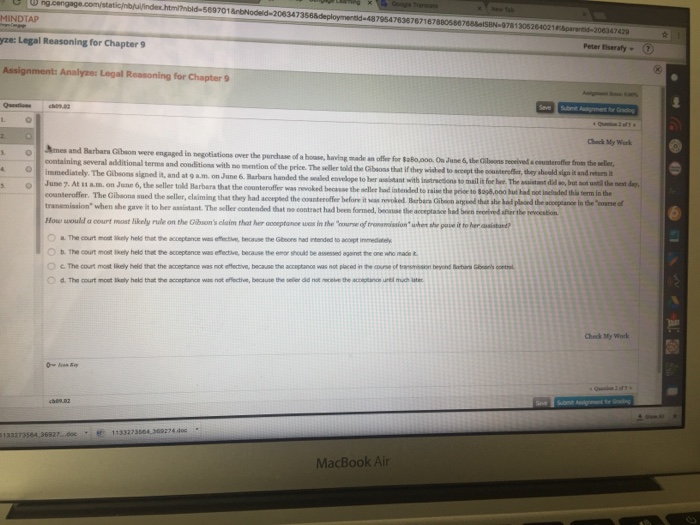Ames and Barbara Gibson were engaged in negotiations over the purchase of a house, having made an offer for exist80,000. On June-6, then Gibson received a counteroffer from the seller, containing several additional terms and conditions with mention of the price. The seller told the Gibson that if they to accept the counteroffer, they should sign it and return it immediately. The Gibson signed it, and at 9 a.m, June 6. Barbara handed the sealed envelope to her assistant with instructions to mail it for her. The assistant did, but soil mail the seat day, June 7. At 11 a m. on June 6, the seller told that the counteroffer was reworked because the seller has instant be the price exist298,000 but that not included this term in the counteroffer. The Gibson issued the seller, claiming that they had accepted the counteroffer before it was reworked. Barbara Gibson assured that she had placed the acceptance in the "course of transmission" when she gave it to her assistant. The seller contended that no contract had been formed, because the acceptance had been retrieved after the How would a court most likely rule on the Gibson's Claim that her acceptance use in the " of transmission" when she if to her assistant? a. The court most likely held that the acceptance was because the Gibson had intended to accept immediately. b. The court most likely held that the acceptance was effective, because the error should be assessed against the one who made it. c The court most likely held that the acceptance was not effective, because the acceptance was not placed in the course of transmission beyond Barbara Gibson control. d. The court mort likely held that the acceptance was not effective, because the seller did not receive the acceptance unit much later. Ames and Barbara Gibson were engaged in negotiations over the purchase of a house, having made an offer for exist80,000. On June-6, then Gibson received a counteroffer from the seller, containing several additional terms and conditions with mention of the price. The seller told the Gibson that if they to accept the counteroffer, they should sign it and return it immediately. The Gibson signed it, and at 9 a.m, June 6. Barbara handed the sealed envelope to her assistant with instructions to mail it for her. The assistant did, but soil mail the seat day, June 7. At 11 a m. on June 6, the seller told that the counteroffer was reworked because the seller has instant be the price exist298,000 but that not included this term in the counteroffer. The Gibson issued the seller, claiming that they had accepted the counteroffer before it was reworked. Barbara Gibson assured that she had placed the acceptance in the "course of transmission" when she gave it to her assistant. The seller contended that no contract had been formed, because the acceptance had been retrieved after the How would a court most likely rule on the Gibson's Claim that her acceptance use in the " of transmission" when she if to her assistant? a. The court most likely held that the acceptance was because the Gibson had intended to accept immediately. b. The court most likely held that the acceptance was effective, because the error should be assessed against the one who made it. c The court most likely held that the acceptance was not effective, because the acceptance was not placed in the course of transmission beyond Barbara Gibson control. d. The court mort likely held that the acceptance was not effective, because the seller did not receive the acceptance unit much later







